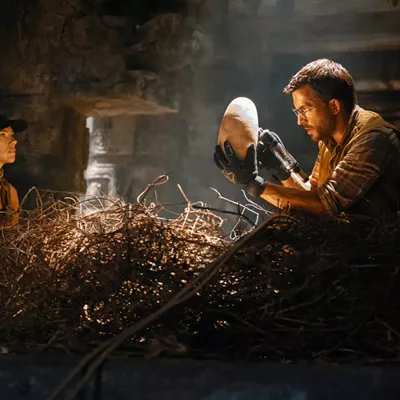This Colombian drama that travels into the heart of the Amazon is a highly original take on the oft-told story of how indigenous cultures are wiped out (often inadvertently) by Western explorers. Yet Embrace of the Serpent is not an ideological treatise or ethnographic document (although it shares commonalities with those approaches): The film is also comic, mysterious and structurally ambitious, while offering numerous points of entry and perspective.
The storyline follows poetic logic more than narrative logic, and as such it becomes a challenge to describe. Embrace of the Serpent stands in sharp rebuke to the truism that history is told by the victors. Ciro Guerra and his co-screenwriter Jacques Toulemonde Vidal incorporate the indigenous people's perspective into the film's narrative arc. Essentially, the film tells two interlocked stories set decades apart, and though it is inspired by the real-life journals of two explorers (Theodor Koch-Grünberg and Richard Evans Schultes), who traveled through the Colombian Amazon in search of the sacred and difficult-to-find yakruna plant, which has psychedelic properties, Embrace is purely fiction.
Theo (Jan Bijvoet, best known for his starring role in Borgman), is an ethnographer who came to the Amazon sometime around the turn of the 20th century. He stayed there for decades, and sent his drawings, photographs, and notebooks back home to be published, yet presumably died in the jungle. His guides were two young native men: the loyal and moderately Westernized Manduca (Yauenkü Migue) and the shaman Karamakate (played by Nilbio Torres as a young man and Antonio Bolívar as an old man), who is the last survivor of his tribe. Years after Theo's disappearance, Evan (Brionne Davis), another scientist, appears and beseeches old Karamakate to accompany him on his search for the yakruna plant. Karamakate insists he has lost all his memories, but due to his belief system, he thinks both scientists have a single soul and are, indeed the same man.
The two journeys taken on the river also echo each other. Trading stops with various native tribes and at a berserk Catholic mission illustrate the filmmaker's ideas about the encroachment of Western civilization. It's filmed in stunning black and white (by David Gallego), which also lends Embrace an air of ethnographic familiarity, as though we are really seeing the recordings of the two scientists, who both, tellingly, use old twin-lens cameras. The film also contains elements of a road movie and the picaresque, but the heart of the movie is Karamakate, whose tale this really is. Embrace of the Serpent does a remarkable job of telling a multifaceted and compelling story.♦















